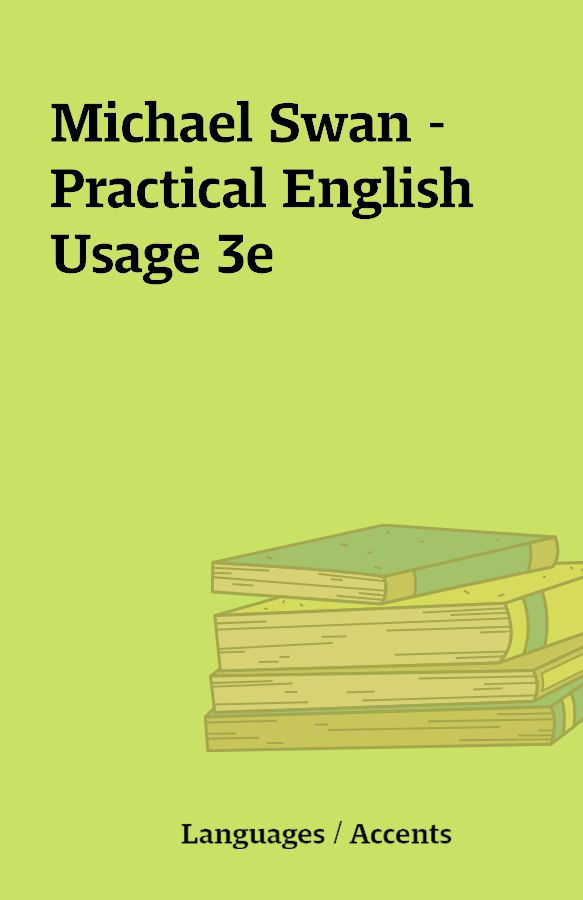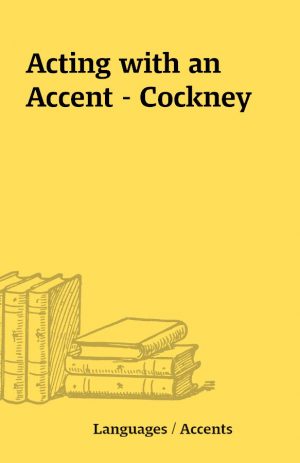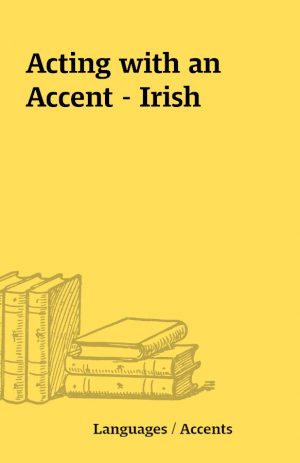Michael Swan – Practical English Usage 3e
Michael Swan – Practical English Usage 3e [1 eBook – PDF]
[1 eBook – PDF]
Description
Michael Swan: Practical English Usage (3rd Edition) This unique reference guide addresses problem points in the language as encountered by learners and their teachers. It gives information and advice that is practical, clear, reliable, and easy to find. Most of the book is about grammar, but it also covers selected points of vocabulary, idiom, style, pronunciation, and spelling.658 pagesPubisher: Oxford University Press, 2005Sorry for the file size. Unfortunately, I only have this version. See http://www.amazon.co.uk/Practical-English-Usage-Michael-Swan/dp/0194420981 for sample pages.Contents summaryAcknowledgments VI Introduction Vlll-X Contents OverviewXl-XVI Language Terminology XVII-XXV Don’t say it: 130 common mistakesXXVI-XXIX Phonetic alphabetPractical English Usage 1-623 Index 624-658 Introduction=The purpose of this book=English. like all languages, is full of problems for the foreign learner. Some of these points are easy to explain – for instance, the formation of questions, the difference between since and for, the meaning of after all. Other problems are more tricky, and cause difficulty even for advanced students and teachers. How exactly is the present perfect used? When do we use past tenses to be polite? What are the differences between at. on and in with expressions of place? We can say a chair leg – why not * a cat leg? When can we use the expression do so? When is the used with superlatives? Is unless the same as if not? What are the differences between come and go, between each and every, between big. large and great, between fairly, quite, rather and pretty? Is it correct to say There’s three more bottles in thefridge1 How do you actually say 3 x 4 = 12? And so on, and so on. Practical English Usage is a guide to problems of this kind. It deals with over 600 points which regularly cause difficulty to foreign students of English. It will be useful, for example, to a learner who is not sure how to use a particular structure. or who has made a mistake and wants to find out why it is wrong. It will also be helpful to a teacher who is looking for a clear explanation of a difficult language point. There is very full coverage of grammar. as well as explanations of a large number of common vocabulary problems. There are also some entries designed to clarify more general questions (e.g. formality, slang. the nature of standard English and dialects) which students and teachers may find themselves concerned with.=Level=The book is intended for higher level students of English and for teachers. Being a reference book, it contains information at various levels, ranging from relatively simple points to quite advanced problems. =Organisation=Problems are mostly explained in short separate entries: the book is more like a dictionary than a grammar in form. This makes it possible to give a clear complete treatment of each point, and enables the user to concentrate just on the question that he or she needs information about. Entries that deal with related topics (e.g, different uses of a tense) are grouped where this is useful, but can be read separately. In longer entries, basic information is generally given first, followed by more detailed explanations and discussions of less important points. Entries are arranged alphabetically by title and numbered in sequence. A comprehensive Index (pages 624-658) shows where each point can be found (see ‘How to find things’. page x). =Approach and style=I have tried to make the presentation as practical as possible. Each entry contains an explanation of a problem. examples of correct usage, and (when this is useful) examples of typical mistakes. In some cases, an explanation may be somewhat different from that found in many learners’ grammars; this is because page viii the rules traditionally given for certain points (e.g. conditionals or indirect speech) are not always accurate or helpful. Explanations are, as far as possible, in simple everyday language. Where it has been necessary to use grammatical tenninology, I have generally preferred to use traditional terms that are simple and easy to understand, except where this would be seriously misleading. Some of these terms (e.g. future tense) would be regarded as unsatisfactory by academic grammarians, but I am not writing for specialists. There is a dictionary of the terminology used in the book on pages xvii-xxv.=The kind of English described=The explanations deal mainly with standard modem everyday British English, and are illustrated with realistic examples of current usage. Both explanations and examples have been thoroughly checked against large electronic databases (‘corpora’) of authentic spoken and written English. Stylistic differences (e.g. between formal and informal usage, or spoken and written language) are mentioned where this is appropriate. The few grammatical differences between British and American English are also described, and there is a good deal of information about other British-American differences, but the book is not intended as a systematic guide to American usage. =Correctness=If people say that a form is not ‘correct’, they can mean several different things. They may for instance be referring to a sentence like * 1 have seen her yesterday, which normally only occurs in the English of foreigners. They may be thinking of a usage like less people (instead of fewer people), which is common in standard English but regarded as wrong by some people. Or they may be talking about forms like * ain’t or ‘double negatives’, which are used in speech by many British and American people, but which do not occur in the standard dialects and are not usually written. This book is mainly concerned with the first kind of ‘correctness’: the differences between British or American English and ‘foreign’ English. However, there is also information about cases of divided usage in standard English, and about a few important dialect forms. (For a discussion of different kinds of English, see 308-309.) =How important is correctness?=If someone makes too many mistakes in a foreign language, he or she can be difficult to understand, so a reasonable level of correctness is important. However, it is quite unnecessary to speak or write a language perfectly in order to communicate effectively (very few adults in fact achieve a perfect command of another language). Learners should aim to avoid serious mistakes (and a book like Practical English Usage will help considerably with this); but they should not become obsessed with correctness, or worry every time they make a mistake. Grammar is not the most important thing in the world! =What this book does not do=Practical English Usage is not a complete guide to the English language. As the title suggests, its purpose is practical: to give learners and their teachers the most important information they need in order to deal with common language problems. Within this framework, the explanations are as complete and accurate as I can make them. However it is not always helpful or possible in a book of this kind to deal with all the details of a complex structural point; so readers may well find occasional exceptions to some of the grammatical rules given here. Equally, the book does not aim to replace a dictionary. While it gives information about common problems with the use of a number of words, it does not attempt to describe other meanings or uses of the words beside those points that are selected for attention. =Other reference books=A book like this gives explanations of individual points of usage, but does not show how the separate points ‘fit together’. Those who need a systematically organised account of the whole of English grammar should consult a book such as the Oxford Learner’s Grammar. by John Eastwood (Oxford University Press), A Student’s Grammar of the English Language, by Greenbaum and Quirk (Longman), or Collins Cobuild English Grammar (Collins). For a detailed treatment of English vocabulary. see the Oxford Advanced Learner’s Dictionary, the Cambridge Advanced Leamer’s Dictionary, the Longman Dictionary of Contemporary English, the Macmillan English Dictionary or the Collins Cobuild English Dictionary. Changes in the third edition English. like all languages, is changing. and British English is currently being quite strongly influenced by American English. Consequently, some usages which were unusual in standard British English a few decades ago have now become common – for example, the use of like as a conjunction (e.g. like I do), or the use of Do you have … ? to ask about the immediate present (e.g. Do you have a light?). The third edition takes account of a number of changes of this kind, in order to give a fully up-to-date description of contemporary usage. =How to find things=The best way to find infonnation about a particular point is to look in the Index on pages 624-658. (The overview on pages xi-xvi is intended only to give a general picture of the topics covered in the book; it is not a complete guide to the contents.) Most points are indexed under several different names, so it is not difficult to locate the entry you need. For instance, if you want to know why we say I’m not used to driving on the left instead of I’m not used to drive on the left, you can find the number of the section where this is explained by looking in the index under fused’. ‘be used’, ‘to’ or ‘-ing forms’. (On the other hand, it would obviously not be helpful to look under ‘drive’: the rule is a general one about the use of -lng forms after be used to, not about the verb drive in particular.)
You must be logged in to post a review.






Reviews
There are no reviews yet.